
Cordia is a genus of flowering plants in the borage family, Boraginaceae. It contains about 300 species of shrubs and trees, that are found worldwide, mostly in warmer regions. Many of the species are commonly called manjack, while bocote may refer to several Central American species in Spanish. The generic name honours German botanist and pharmacist Valerius Cordus (1515–1544). Like most other Boraginaceae, the majority have trichomes (hairs) on the leaves.
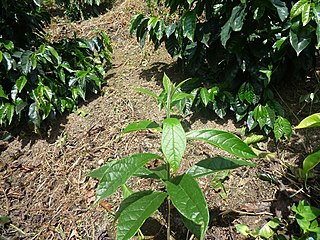
Cordia alliodora is a species of flowering tree in the borage family, Boraginaceae, that is native to the American tropics. It is commonly known as Spanish elm, Ecuador laurel, cypre or salmwood. It can reach 35 m in height.
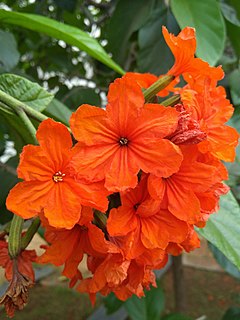
Cordia sebestena is a shrubby tree in the borage family, Boraginaceae, native to the American tropics. It ranges from southern Florida in the United States and the Bahamas, southwards throughout Central America and the Greater Antilles. Common names have included siricote or kopté (Mayan) in 19th Century northern Yucatán, scarlet cordia in Jamaica, and Geiger tree in Florida.

Hesperidin is a flavanone glycoside found in citrus fruits. Its aglycone form is called hesperetin. Its name is derived from the word "hesperidium", for fruit produced by citrus trees.

Hesperetin is the 4'-methoxy derivative of eriodictyol, a flavanone. Hesperetin's 7-O-glycoside, hesperidin, is a naturally occurring flavanon-glycoside, the main flavonoid in lemons and sweet oranges. Hesperetin are not found to a significant extent in Citrus spp.
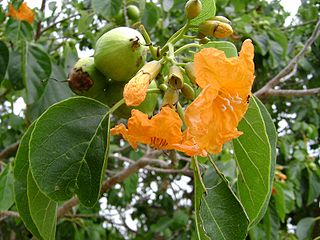
Cordia subcordata is a species of flowering tree in the borage family, Boraginaceae, that occurs in eastern Africa, South Asia, Southeast Asia, northern Australia and the Pacific Islands. The plant is known by a variety of names including beach cordia, sea trumpet, and kerosene wood, among others.

Eucalyptus obliqua, commonly known as messmate stringybark or messmate, but also known as brown top, brown top stringbark, stringybark or Tasmanian oak, is a species of tree that is endemic to south-eastern Australia. It has rough, stringy or fibrous bark on the trunk and larger branches, smooth greyish bark on the thinnest branches, lance-shaped to curved adult leaves, flower buds in groups of seven to fifteen or more, white flowers and cup-shaped or barrel-shaped fruit.
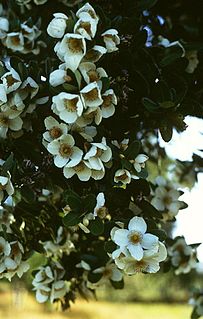
Eucryphia cordifolia, the ulmo, is a species of tree in the family Cunoniaceae. It is found in Chile and Argentina. It is threatened by logging and habitat loss. The natural habitat is along the Andes Range from 38 to 43°S, and up to 700 meters (2300 ft) above sea level. It is a very elegant tree with a thick trunk and wide crown and can become over 12 m (40 ft) high. It blooms in February and March, depending on latitude and altitude. The fruit is a capsule about 1.5 cm (0.6 in) length.

Nothofagus obliqua, commonly known as Patagonian oak, roble, pellín, roble pellín, and hualle in its early state of growth or roble beech, is a deciduous tree from Chile and Argentina. It grows from 33 to 43° south latitude. The northern extent of this tree's range in Chile is considered to be the Vizcachas Mountains and La Campana National Park. N. obliqua was proposed to be renamed Lophozonia obliqua in 2013.
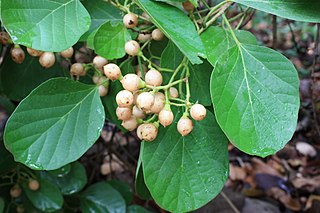
Cordia myxa is a species of flowering plant in the borage family, Boraginaceae. It is a medium-sized broad-leaved deciduous tree. Common names include Assyrian plum, lasura, pidar, panugeri, naruvilli, geduri, spistan, burgund dulu wanan and ntege. It is found growing primarily in Asia, as well as, across the globe especially in tropical regions having the right type of geophysical environment. It is seen coming up naturally and growing abundantly from Myanmar in the east to Lebanon and Syria in the west. Its habitat starts at about 200 m above mean sea level in the plains and ascends to an altitude around 1,500 m in the hills.

Ficus obliqua, commonly known as the small-leaved fig, is a tree in the family Moraceae, native to eastern Australia, New Guinea, eastern Indonesia to Sulawesi and islands in the southwestern Pacific Ocean. Previously known for many years as Ficus eugenioides, it is a banyan of the genus Ficus, which contains around 750 species worldwide in warm climates, including the edible fig. Beginning life as a seedling, which grows on other plants (epiphyte) or on rocks (lithophyte), F. obliqua can grow to 60 m (200 ft) high and nearly as wide with a pale grey buttressed trunk, and glossy green leaves.
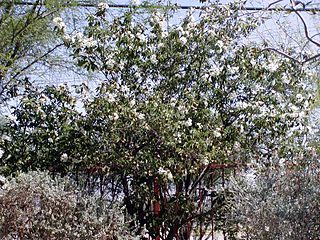
Cordia boissieri is a species of flowering shrub or small tree in the borage family, Boraginaceae. Its native range extends from southern Texas in the United States south to central Mexico. Common names include anacahuita, Mexican olive, white cordia, and Texas wild olive. It is named after botanist Pierre Edmond Boissier.

Azalein is a chemical compound. It is a flavonol, a type of flavonoid. It is the 3-O-α-L-rhamnoside of azaleatin. It can be found in the flowers of Plumbago and Rhododendron species.

Herbacetin is a flavonol, a type of flavonoid.

Rhodionin is a herbacetin rhamnoside found in Rhodiola species.
Cordia platythyrsa is a species of flowering plant in the borage family, Boraginaceae, found in Africa and is native to Cameroon, Congo, Ivory Coast, Equatorial Guinea, Gabon, the Gambia, Ghana, Guinea, Guinea Bissau, Liberia, Nigeria, Senegal, Sierra Leone, Togo, and the Democratic Republic of the Congo. The tree grows to over 30 m in height and 1 m in diameter. The wood is pale yellow to almost white in color and used mainly for furniture making, interior joinery, domestic items, canoes, and musical instruments. It has low density (0.5 g/cm3) and is very soft, with a spongy, fibrous texture.
Brenthia coronigera, commonly known as the metalmark moth, is a species of moth of the family Choreutidae. It was described by Edward Meyrick in 1918. It is found in the Bengal region of what was British India.

Hakea obliqua, commonly known as needles and corks, is a shrub in the family Proteaceae and is endemic to an area in the Wheatbelt, Great Southern and Goldfields-Esperance regions of Western Australia.

Monstera obliqua is a species of the genus Monstera native to Central and South America. The most well known form of obliqua is the one from Peru, often described as being "more holes than leaf" but there are forms in the obliqua complex with little to no fenestration such as the Bolivian type. An illustration of the general variation in adult leaf shape from different individuals of this species can be found in Michael Madison's 'A Revision of Monstera'. An hemiepiphytic climber like most other Monstera species, obliqua is particularly known for its foliage, which is often highly fenestrated, to the point where there is more empty space than leaf. Quite expensive in cultivation, this species is often confused for other Monstera like Monstera adansonii.
















